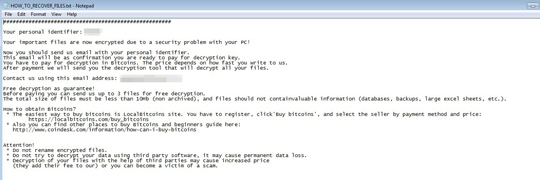Ransom_MIMICRY.THIOGAH
Trojan.Win32.Hesv.dlcf (Kaspersky)
Windows


Threat Type: Ransomware
Destructiveness: No
Encrypted: Yes
In the wild: Yes
OVERVIEW
This Ransomware arrives as an attachment to email messages spammed by other malware/grayware or malicious users. It arrives on a system as a file dropped by other malware or as a file downloaded unknowingly by users when visiting malicious sites.
It is capable of encrypting files in the affected system.
It drops files as ransom note.
TECHNICAL DETAILS
Arrival Details
This Ransomware arrives as an attachment to email messages spammed by other malware/grayware or malicious users.
It arrives on a system as a file dropped by other malware or as a file downloaded unknowingly by users when visiting malicious sites.
Other Details
This Ransomware encrypts files with the following extensions:
- .good
It does the following:
- It drops a ransom note in every directory that the malware had successfully encrypted.
- It needs to connect to the following server to proceed to its file encryption routine:
- {BLOCKED}.{BLOCKED}.17.172
- After its encryption routine it will open the dropped ransom note text file "C:\HOW_TO_RECOVER_FILES.txt".
- mimicry.jpg
- It will encrypt all files in all drives except the C drive.
It is capable of encrypting files in the affected system.
Ransomware Routine
This Ransomware drops the following file(s) as ransom note:
- {File Directory}\HOW_TO_RECOVER_FILES.txt

SOLUTION
Step 1
Before doing any scans, Windows XP, Windows Vista, and Windows 7 users must disable System Restore to allow full scanning of their computers.
Step 2
Note that not all files, folders, and registry keys and entries are installed on your computer during this malware's/spyware's/grayware's execution. This may be due to incomplete installation or other operating system conditions. If you do not find the same files/folders/registry information, please proceed to the next step.
Step 3
Search and delete these files
- {Encrpyted Directory}\HOW_TO_RECOVER_FILES.txt
Step 4
Restore encrypted files from backup.
Step 5
Scan your computer with your Trend Micro product to delete files detected as Ransom_MIMICRY.THIOGAH. If the detected files have already been cleaned, deleted, or quarantined by your Trend Micro product, no further step is required. You may opt to simply delete the quarantined files. Please check the following Trend Micro Support pages for more information:
Did this description help? Tell us how we did.


